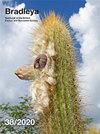Genus Mammillaria Haw. in the Yucatán Peninsula
IF 1.2
4区 生物学
Q3 PLANT SCIENCES
引用次数: 0
Abstract
Summary: Two species of the genus Mammillaria Haw. are the only globular cacti belonging to the family Cactaceae that have been reported from the Yucatán Peninsula, occurring only in the northernmost coastal areas of the Mexican state of Yucatán. While Mammillaria heyderi subsp. gaumeri is a relatively common cactus inhabiting various types of biotopes (from stabilised coastal sand dunes to dry tropical deciduous forests), Mammillaria columbiana subsp. yucatanensis has been re-discovered in its habitat near Progreso (type locality) only very recently and only a few specimens have been so far reported. Thus, although recorded from other parts of Mesoamerica, M. columbiana subsp. yucatanensis should be considered as a very endangered plant in Yucatán Peninsula, deserving the special protection status. The biggest threat to both cacti is the destruction of their habitats due to the urbanisation of the coastal areas.Mammillaria Haw属。在尤卡坦半岛
文章摘要:毛贝母属两种。是尤卡坦半岛唯一一种仙人掌科球状仙人掌,仅分布在墨西哥尤卡坦州最北部沿海地区。而海毛母亚种。高梅里是一种相对常见的仙人掌,栖息在各种类型的生境中(从稳定的海岸沙丘到干燥的热带落叶林)。最近才在Progreso(模式区)附近的栖息地重新发现了yucatanensis,迄今为止只报道了少数标本。因此,尽管从中美洲的其他地区记录到哥伦比亚M.columbiana亚种。yucatanensis应被认为是尤卡坦半岛的一种非常濒危的植物,值得特别保护。这两种仙人掌面临的最大威胁是,由于沿海地区的城市化,它们的栖息地遭到破坏。
本文章由计算机程序翻译,如有差异,请以英文原文为准。
求助全文
约1分钟内获得全文
求助全文
来源期刊

Bradleya
PLANT SCIENCES-
CiteScore
2.80
自引率
25.00%
发文量
43
审稿时长
>12 weeks
期刊介绍:
Bradleya is the BCSS contribution to the scientific world and is accepted as such because of its academic standards. It can only flourish with the support of BCSS members, many of whom subscribe to it each year. The aim is to include articles which our members will find interesting and educational, whilst retaining rigorous standards of publication. Scientifically important articles don''t have to be dull to read. So, because Bradleya depends the subscriber, the editor endeavours to make its contents accessible, easily understood and enjoyable for all.
 求助内容:
求助内容: 应助结果提醒方式:
应助结果提醒方式:


